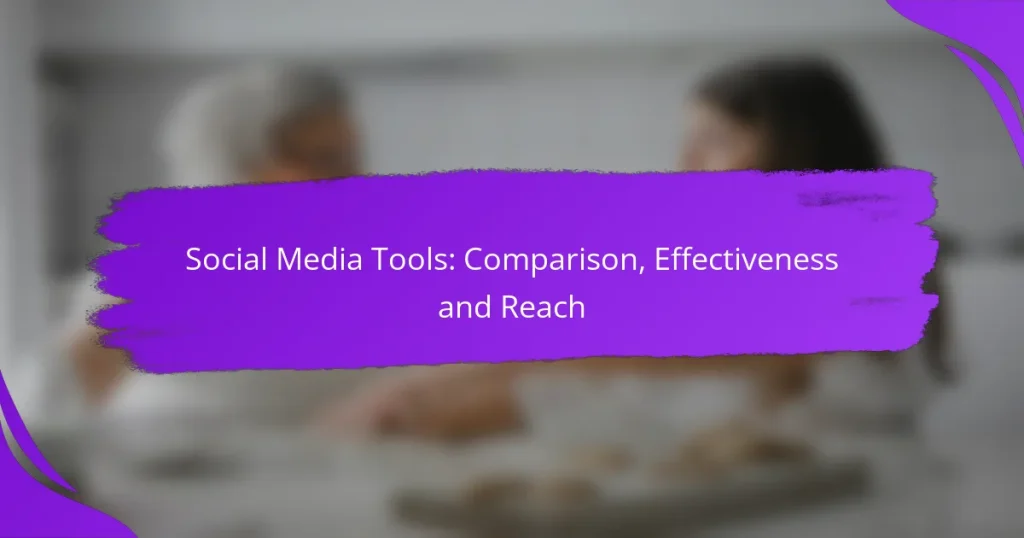In today’s digital landscape, social media tools are essential for e-commerce businesses seeking to optimize their marketing strategies and engage effectively with customers. By offering features such as content scheduling, performance analytics, and audience targeting, these platforms help brands maximize their reach and streamline their operations. A careful comparison of these tools can reveal which best aligns with your specific marketing goals and workflow needs.
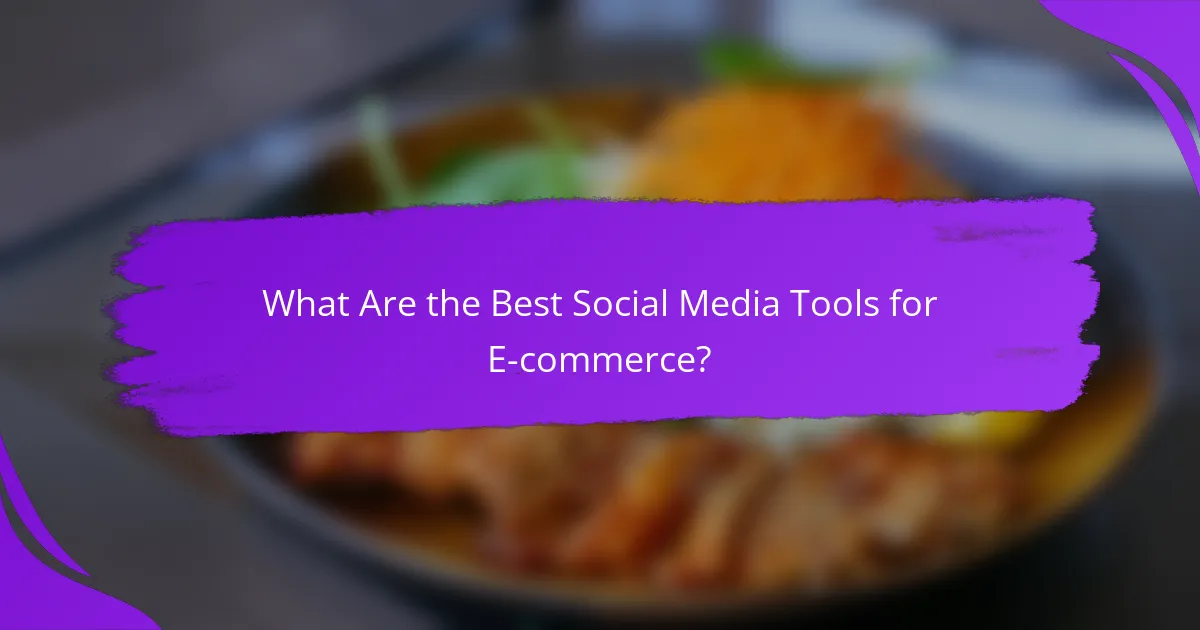
What Are the Best Social Media Tools for E-commerce?
The best social media tools for e-commerce streamline marketing efforts, enhance customer engagement, and improve sales. These platforms offer features tailored to manage social media accounts, analyze performance, and schedule posts effectively.
Hootsuite
Hootsuite is a comprehensive social media management tool that allows e-commerce businesses to schedule posts, monitor engagement, and analyze performance across multiple platforms. Its user-friendly dashboard helps track conversations and brand mentions, making it easier to engage with customers.
Consider using Hootsuite for its robust analytics and reporting features, which can help you understand which content resonates most with your audience. However, be mindful of its pricing structure, which can increase with the number of users and features needed.
Buffer
Buffer is known for its simplicity and effectiveness in scheduling posts across various social media channels. It provides a clean interface that allows e-commerce businesses to plan their content and analyze engagement metrics easily.
One advantage of Buffer is its browser extension, which enables quick sharing of content while browsing. However, its analytics may not be as detailed as some competitors, so consider your reporting needs when choosing this tool.
Sprout Social
Sprout Social offers advanced social media management features, including scheduling, monitoring, and analytics tailored for e-commerce. Its powerful reporting tools can help you track performance metrics and customer engagement effectively.
This tool is particularly useful for businesses looking to enhance customer service through social media, as it allows for easy management of messages and comments. However, its pricing can be on the higher side, making it more suitable for larger e-commerce operations.
Later
Later specializes in visual content scheduling, making it ideal for e-commerce brands that rely heavily on images and videos. Its drag-and-drop calendar simplifies the scheduling process, allowing businesses to plan their posts visually.
Later also provides features like user-generated content curation and link-in-bio tools, which can enhance engagement. Keep in mind that while it’s great for Instagram, its capabilities for other platforms may be limited compared to more comprehensive tools.
SocialBee
SocialBee focuses on content recycling and categorization, making it a strong choice for e-commerce businesses looking to maximize their content’s lifespan. It allows users to create categories for different types of posts, ensuring a balanced content mix.
This tool is particularly beneficial for maintaining a consistent posting schedule without needing to create new content constantly. However, its learning curve may be steeper for beginners, so consider investing time in training to fully utilize its features.
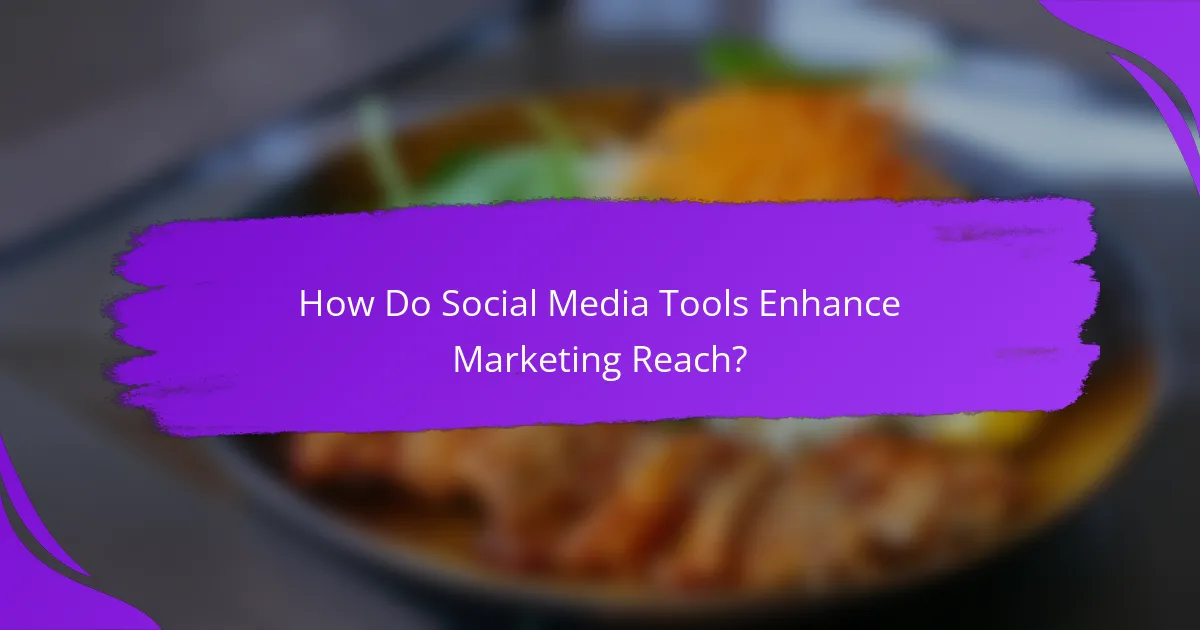
How Do Social Media Tools Enhance Marketing Reach?
Social media tools enhance marketing reach by enabling businesses to connect with larger audiences, streamline content distribution, and analyze engagement metrics effectively. These tools facilitate targeted marketing efforts, allowing brands to engage with specific demographics and track their performance in real time.
Increased audience engagement
Social media tools foster increased audience engagement by providing features that allow brands to interact directly with their followers. This includes responding to comments, conducting polls, and sharing user-generated content, which can significantly boost brand loyalty.
Using tools like chatbots or live chat features can further enhance engagement by providing instant responses to customer inquiries. Brands that actively engage with their audience often see higher interaction rates, which can lead to improved conversion rates.
Improved content scheduling
Effective content scheduling is crucial for maintaining a consistent online presence. Social media tools allow marketers to plan and automate posts across multiple platforms, ensuring that content is shared at optimal times for maximum visibility.
For example, tools like Buffer or Hootsuite enable users to schedule posts weeks in advance, allowing for strategic planning around product launches or seasonal campaigns. This not only saves time but also helps maintain a steady flow of content, which is essential for audience retention.
Analytics and performance tracking
Analytics and performance tracking are vital components of any social media strategy. Tools provide insights into engagement metrics, audience demographics, and content performance, helping marketers understand what resonates with their audience.
By regularly reviewing analytics, businesses can adjust their strategies to focus on high-performing content types and refine their targeting. Many tools offer customizable dashboards that display key performance indicators, making it easier to track progress and make data-driven decisions.
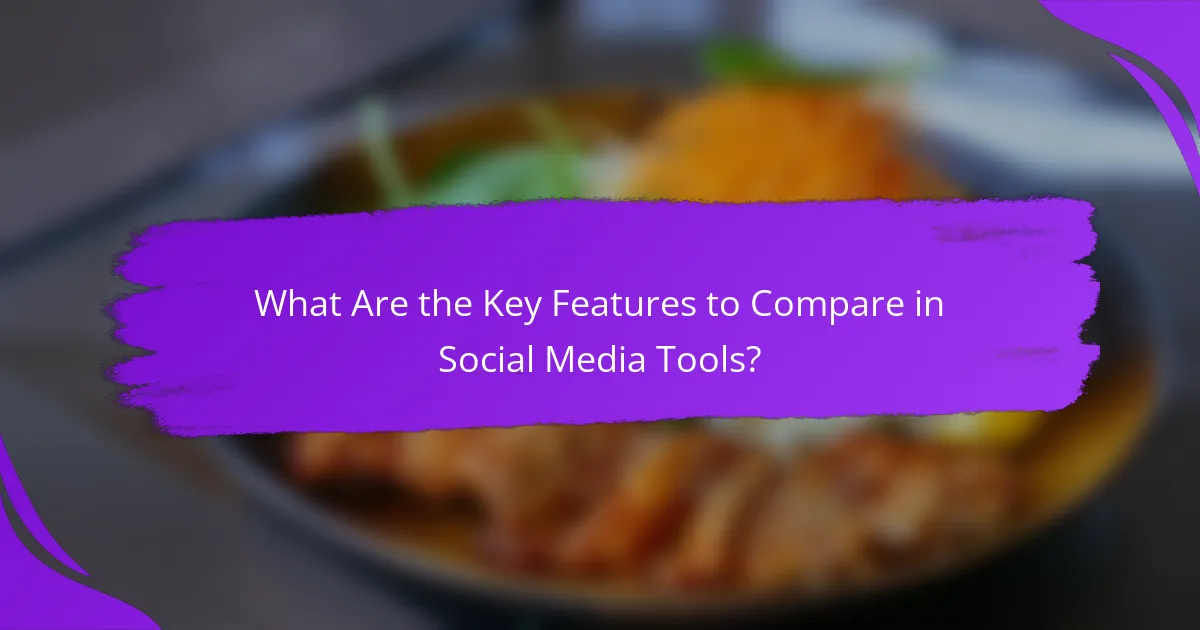
What Are the Key Features to Compare in Social Media Tools?
When comparing social media tools, focus on features that enhance your marketing strategy and streamline your workflow. Key aspects include content scheduling, analytics capabilities, integration with e-commerce platforms, and user interface and experience.
Content scheduling
Content scheduling allows users to plan and automate posts across various social media platforms. This feature is crucial for maintaining a consistent online presence and can save time by allowing bulk uploads or calendar views for better organization.
Look for tools that offer flexible scheduling options, such as time zone adjustments and recurring posts. Popular platforms often provide features like drag-and-drop calendars and the ability to preview posts before they go live.
Analytics capabilities
Analytics capabilities are essential for measuring the effectiveness of your social media efforts. These tools provide insights into engagement metrics, audience demographics, and post performance, helping you refine your strategy.
Choose tools that offer customizable reports and real-time data tracking. Features like A/B testing and sentiment analysis can also enhance your understanding of audience interactions and preferences.
Integration with e-commerce platforms
Integration with e-commerce platforms enables seamless connections between social media and online stores. This feature is vital for businesses looking to drive sales directly through social channels.
Evaluate tools that support popular e-commerce platforms, such as Shopify or WooCommerce, and offer features like shoppable posts or direct checkout options. This can significantly enhance your conversion rates and streamline the customer journey.
User interface and experience
A user-friendly interface is crucial for maximizing the effectiveness of social media tools. An intuitive design can reduce the learning curve and improve overall productivity when managing multiple accounts.
Look for tools that offer customizable dashboards, easy navigation, and mobile accessibility. A positive user experience can lead to better engagement and more efficient management of your social media presence.
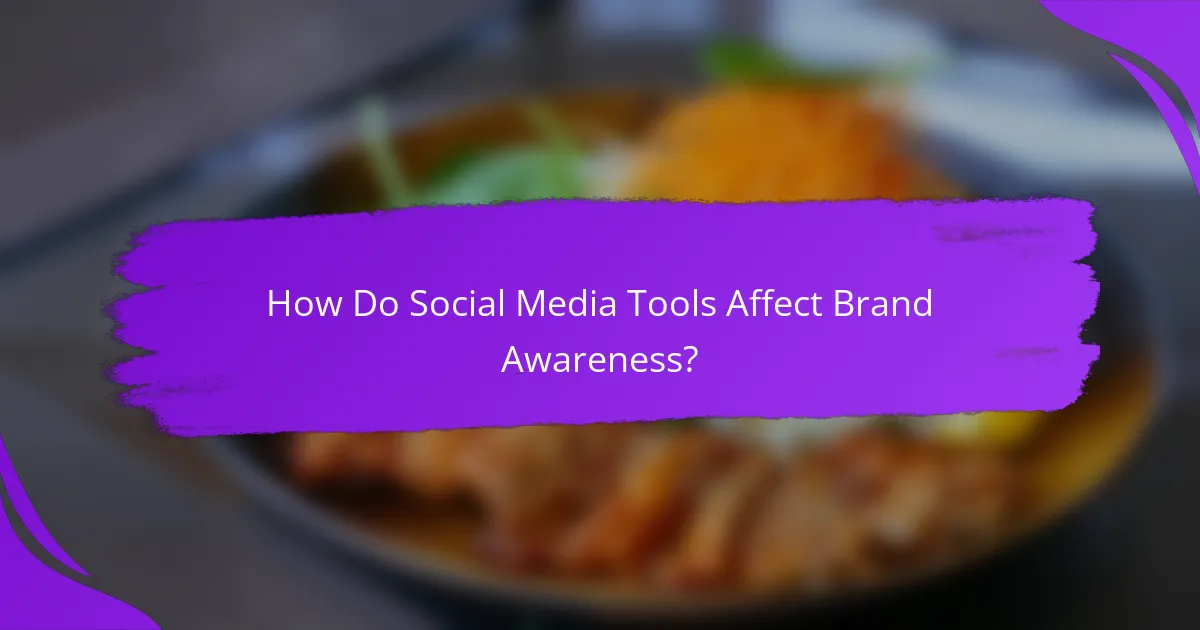
How Do Social Media Tools Affect Brand Awareness?
Social media tools significantly enhance brand awareness by increasing visibility, enabling targeted advertising, and fostering community engagement. These platforms allow brands to reach a wider audience and create lasting impressions through strategic content and interactions.
Enhanced visibility
Enhanced visibility through social media tools means brands can showcase their products and services to a larger audience. By utilizing platforms like Facebook, Instagram, and Twitter, businesses can reach millions of potential customers quickly and effectively.
Regular posting, engaging content, and the use of hashtags can improve a brand’s visibility. For example, brands that post consistently may see engagement rates increase by 20-30%, leading to greater recognition and recall among consumers.
Targeted advertising
Targeted advertising allows brands to reach specific demographics based on user data, interests, and behaviors. Social media platforms provide detailed targeting options, enabling businesses to tailor their ads to the right audience, which can significantly improve conversion rates.
For instance, a local coffee shop can target ads to users within a certain radius who have shown interest in coffee or local events. This precision can lead to higher engagement and a better return on investment, often yielding lower costs per acquisition compared to traditional advertising methods.
Community building
Community building on social media fosters a sense of belonging among customers, enhancing brand loyalty. By creating spaces for interaction, brands can engage with their audience directly, responding to questions and feedback in real-time.
Brands can facilitate community building through forums, groups, or live events. For example, hosting a Q&A session on Instagram Live can strengthen connections with followers, making them feel valued and more likely to advocate for the brand. Consistent interaction can lead to a loyal customer base that actively promotes the brand within their networks.
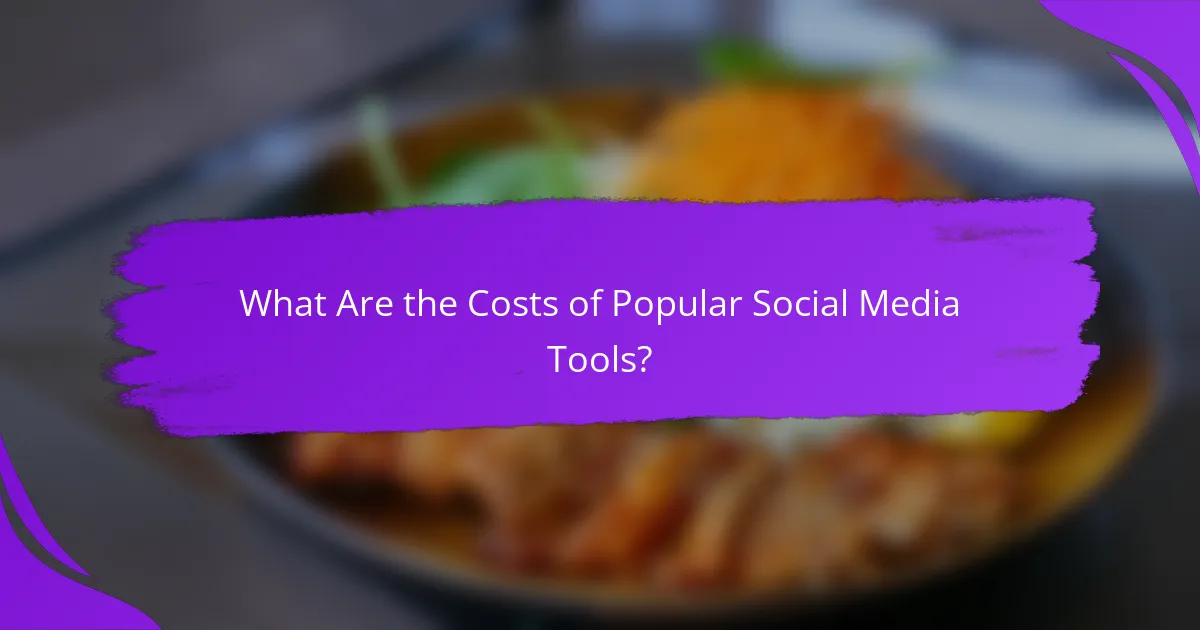
What Are the Costs of Popular Social Media Tools?
The costs of popular social media tools can vary significantly based on features, user base, and subscription plans. Many tools offer free tiers with limited functionality, while premium plans can range from a few dollars to several hundred per month, depending on the scale and capabilities required.
Free Tools
Many social media tools provide free versions that allow users to manage basic tasks like scheduling posts and tracking engagement. Examples include Hootsuite’s free plan and Buffer’s limited free tier. While these options are budget-friendly, they often come with restrictions on the number of accounts or features available.
Subscription Plans
Subscription plans for social media tools typically range from around $10 to $300 per month. These plans usually offer advanced features such as analytics, team collaboration, and enhanced customer support. For instance, tools like Sprout Social and HubSpot provide tiered pricing based on the number of users and features needed.
Enterprise Solutions
For larger organizations, enterprise solutions can cost significantly more, often starting at several hundred dollars per month and going into the thousands. These packages usually include custom features, dedicated account management, and extensive analytics capabilities. Companies like Salesforce and Adobe offer tailored solutions that cater to specific business needs.
Additional Costs
In addition to subscription fees, users should consider potential extra costs such as add-ons, training, or third-party integrations. Some tools may charge for premium features, while others might require payment for additional user seats. It’s essential to evaluate the total cost of ownership when selecting a social media tool.
